Information injection-pump assembly
ZEXEL
106671-3590
1066713590
HINO
220003970A
220003970a
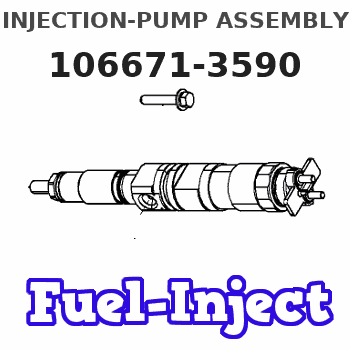
Rating:
Cross reference number
ZEXEL
106671-3590
1066713590
HINO
220003970A
220003970a
Zexel num
Bosch num
Firm num
Name
Calibration Data:
Adjustment conditions
Test oil
1404 Test oil ISO4113 or {SAEJ967d}
1404 Test oil ISO4113 or {SAEJ967d}
Test oil temperature
degC
40
40
45
Nozzle and nozzle holder
105780-8140
Bosch type code
EF8511/9A
Nozzle
105780-0000
Bosch type code
DN12SD12T
Nozzle holder
105780-2080
Bosch type code
EF8511/9
Opening pressure
MPa
17.2
Opening pressure
kgf/cm2
175
Injection pipe
Outer diameter - inner diameter - length (mm) mm 8-3-600
Outer diameter - inner diameter - length (mm) mm 8-3-600
Overflow valve opening pressure
kPa
162
147
177
Overflow valve opening pressure
kgf/cm2
1.65
1.5
1.8
Tester oil delivery pressure
kPa
157
157
157
Tester oil delivery pressure
kgf/cm2
1.6
1.6
1.6
Direction of rotation (viewed from drive side)
Left L
Left L
Injection timing adjustment
Direction of rotation (viewed from drive side)
Left L
Left L
Injection order
1-4-2-6-
3-5
Pre-stroke
mm
3.3
3.24
3.3
Beginning of injection position
Drive side NO.1
Drive side NO.1
Difference between angles 1
Cal 1-4 deg. 60 59.75 60.25
Cal 1-4 deg. 60 59.75 60.25
Difference between angles 2
Cyl.1-2 deg. 120 119.75 120.25
Cyl.1-2 deg. 120 119.75 120.25
Difference between angles 3
Cal 1-6 deg. 180 179.75 180.25
Cal 1-6 deg. 180 179.75 180.25
Difference between angles 4
Cal 1-3 deg. 240 239.75 240.25
Cal 1-3 deg. 240 239.75 240.25
Difference between angles 5
Cal 1-5 deg. 300 299.75 300.25
Cal 1-5 deg. 300 299.75 300.25
Injection quantity adjustment
Adjusting point
A
Rack position
10.4
Pump speed
r/min
500
500
500
Average injection quantity
mm3/st.
130.5
127.5
133.5
Max. variation between cylinders
%
0
-4
4
Fixing the lever
*
Injection quantity adjustment_02
Adjusting point
B
Rack position
10.9
Pump speed
r/min
700
700
700
Average injection quantity
mm3/st.
146
144
148
Max. variation between cylinders
%
0
-2
2
Basic
*
Fixing the lever
*
Injection quantity adjustment_03
Adjusting point
C
Rack position
11.3
Pump speed
r/min
1150
1150
1150
Average injection quantity
mm3/st.
152.5
149.5
155.5
Max. variation between cylinders
%
0
-4
4
Fixing the lever
*
Injection quantity adjustment_04
Adjusting point
D
Rack position
6.6+-0.5
Pump speed
r/min
225
225
225
Average injection quantity
mm3/st.
16
13
19
Max. variation between cylinders
%
0
-10
10
Fixing the rack
*
Injection quantity adjustment_05
Adjusting point
E
Rack position
11+-0.5
Pump speed
r/min
100
100
100
Average injection quantity
mm3/st.
125
125
145
Fixing the lever
*
Timer adjustment
Pump speed
r/min
950
Advance angle
deg.
0.5
Timer adjustment_02
Pump speed
r/min
1000
Advance angle
deg.
1.5
Timer adjustment_03
Pump speed
r/min
1050
Advance angle
deg.
1.9
1.4
2.4
Timer adjustment_04
Pump speed
r/min
1150
Advance angle
deg.
4.5
4.2
4.8
Remarks
Finish
Finish
Test data Ex:
Governor adjustment
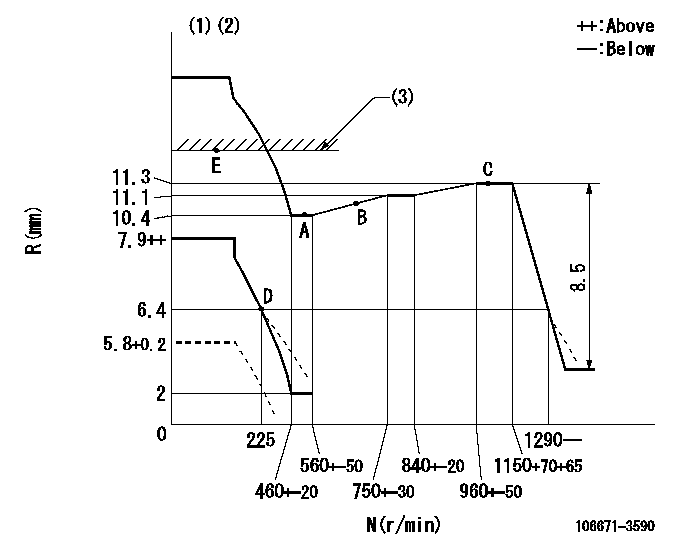
N:Pump speed
R:Rack position (mm)
(1)Beginning of damper spring operation: DL
(2)Set the load lever's stop position so that R = aa (N = 0).
(3)RACK LIMIT
----------
DL=5.5-0.2mm aa=5.8+0.2mm
----------
----------
DL=5.5-0.2mm aa=5.8+0.2mm
----------
Speed control lever angle

F:Full speed
----------
----------
a=5deg+-5deg
----------
----------
a=5deg+-5deg
0000000901
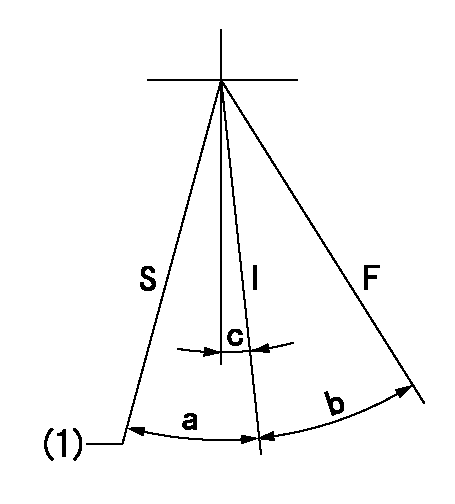
F:Full load
I:Idle
S:Stop
(1)Rack position aa (pump speed bb r/min )
----------
aa=5.8+0.2mm bb=0r/min
----------
a=13deg+-3deg b=31deg+-3deg c=1deg+-5deg
----------
aa=5.8+0.2mm bb=0r/min
----------
a=13deg+-3deg b=31deg+-3deg c=1deg+-5deg
Stop lever angle
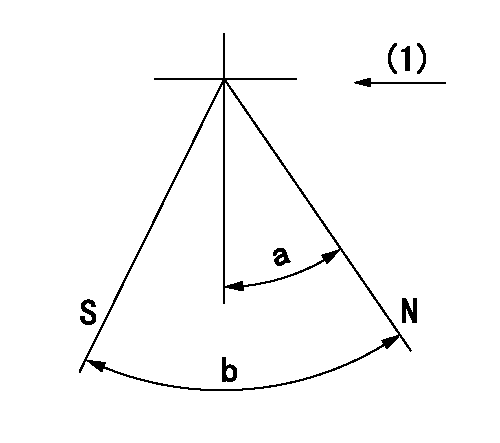
N:Pump normal
S:Stop the pump.
(1)Drive side
----------
----------
a=40deg+-5deg b=64deg+-5deg
----------
----------
a=40deg+-5deg b=64deg+-5deg
0000001501 MICRO SWITCH
Switch adjustment
Adjust the bolt so that the lower lever position is obtained when the switch is turned ON.
(1)Speed N1
(2)Rack position Ra
----------
N1=300+25r/min Ra=6.4mm
----------
----------
N1=300+25r/min Ra=6.4mm
----------
0000001601 GOVERNOR TORQUE CONTROL
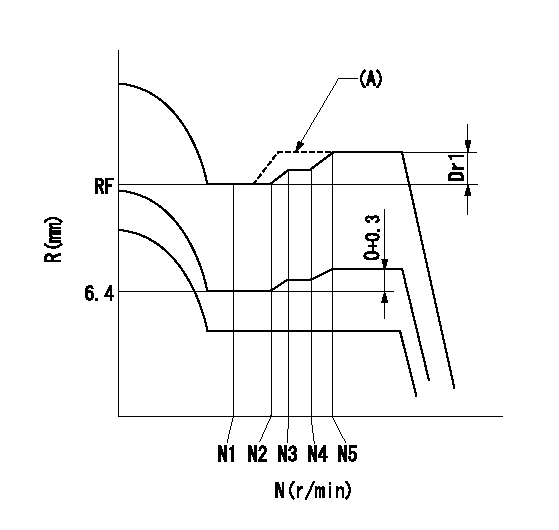
Dr:Torque control stroke
(A): Without torque control spring capsule
1. Adjustment procedures
(1)Procedure is the same as that for the RFD (former type), except that the positive torque control stroke must be determined at the full lever setting.
2. Procedures for adjustment
(1)Remove the torque control spring capsule.
(2)Operate the pump at approximately N1. (End of idling spring operation < N1.)
(3)Tilt the lever to the full side.
(4)Set so that R = RF.
(5)Increase the speed by pushing in the screw (attached to the bracket on the rear of the tension lever) through the adjusting window.
(6)Adjust so that the torque control stroke Dr1 can be obtained.
(7)Align N2 N3, N4 and N5 using the torque control spring capsule.
----------
N1=500r/min N2=560+-50r/min N3=750+-30r/min N4=840+-20r/min N5=960+-50r/min RF=10.4mm Dr1=0.9mm
----------
----------
N1=500r/min N2=560+-50r/min N3=750+-30r/min N4=840+-20r/min N5=960+-50r/min RF=10.4mm Dr1=0.9mm
----------
Information:
Programmable Features
The PEEC engine has the programmable features of cruise control, PTO governing, vehicle speed limiting, high gears rpm limiting, low gears rpm limiting, TEL rpm limiting, idle shutdown timer and retarder coast/latch included in its functions.Cruise Control
Typical InstallationCruise control reduces driver fatigue and improves vehicle ride by eliminating throttle bounce. Cruise control can also reduce fuel consumption and driver to driver variations in a large fleet.* Vehicle speed MUST be ABOVE the low cruise control speed limit [typically 30 mph (48 km/h)].* Set the ON/OFF switch to the ON position.* Accelerate vehicle to desired speed.* Move the SET/RESUME switch momentarily into the SET position. The engine will maintain the speed that the truck is traveling when the SET switch is released. If the SET switch is held for more than one second, the truck speed will continue to increase until the SET switch is released. The cruise speed will then be set to the speed the truck is traveling when the SET switch is released.* Move the ON/OFF switch to the OFF position, or ...* Depress the clutch pedal, or ...* Depress the service brake pedal.* Return the ON/OFF switch to the ON position, and/or ...*Place the SET/RESUME switch momentarily into the RESUME position. The PEEC system remembers the last cruise control set speed as long as the engine is running.If the RESUME switch is held for more than one second, the PEEC system will decrease the truck speed and a new set speed will be established when the RESUME switch is released.The throttle can be used to exceed the cruise control set speed, if the high cruise limit is lower than the vehicle speed limit. Releasing the throttle will return the truck to the previous cruise speed. The throttle override can be used to anticipate hills or for passing situations.To shift gears, the ON/OFF switch can be moved to the OFF position or disengage the clutch to deactivate the cruise control.After shifting gears, the cruise control can be reactivated by moving the ON/OFF switch to the ON position and/or momentarily setting the SET/RESUME switch in the RESUME position. The PEEC system may have a maximum cruise speed which has been specified by the owner of the truck. The cruise control will only function between the programmed Low Cruise Control Limit (LCC) and High Cruise Control Limit (HCC). The High Cruise Control set limit is also generally set at a lower mph (km/h) than the vehicle speed limit.PTO Governor Mode
The cruise control function of the PEEC system works as a PTO governor or engine speed governor when the vehicle is stationary or when operated at a vehicle speed below the PTO Vehicle Speed Limit (PTO VSL). Activation and deactivation of the PTO governor is the same as the cruise control.The PTO governor will operate at any engine rpm from low idle to the maximum PTO limit rpm (which is usually less than rated engine rpm). The maximum PTO governor speed is a customer specified parameter.* To operate
The PEEC engine has the programmable features of cruise control, PTO governing, vehicle speed limiting, high gears rpm limiting, low gears rpm limiting, TEL rpm limiting, idle shutdown timer and retarder coast/latch included in its functions.Cruise Control
Typical InstallationCruise control reduces driver fatigue and improves vehicle ride by eliminating throttle bounce. Cruise control can also reduce fuel consumption and driver to driver variations in a large fleet.* Vehicle speed MUST be ABOVE the low cruise control speed limit [typically 30 mph (48 km/h)].* Set the ON/OFF switch to the ON position.* Accelerate vehicle to desired speed.* Move the SET/RESUME switch momentarily into the SET position. The engine will maintain the speed that the truck is traveling when the SET switch is released. If the SET switch is held for more than one second, the truck speed will continue to increase until the SET switch is released. The cruise speed will then be set to the speed the truck is traveling when the SET switch is released.* Move the ON/OFF switch to the OFF position, or ...* Depress the clutch pedal, or ...* Depress the service brake pedal.* Return the ON/OFF switch to the ON position, and/or ...*Place the SET/RESUME switch momentarily into the RESUME position. The PEEC system remembers the last cruise control set speed as long as the engine is running.If the RESUME switch is held for more than one second, the PEEC system will decrease the truck speed and a new set speed will be established when the RESUME switch is released.The throttle can be used to exceed the cruise control set speed, if the high cruise limit is lower than the vehicle speed limit. Releasing the throttle will return the truck to the previous cruise speed. The throttle override can be used to anticipate hills or for passing situations.To shift gears, the ON/OFF switch can be moved to the OFF position or disengage the clutch to deactivate the cruise control.After shifting gears, the cruise control can be reactivated by moving the ON/OFF switch to the ON position and/or momentarily setting the SET/RESUME switch in the RESUME position. The PEEC system may have a maximum cruise speed which has been specified by the owner of the truck. The cruise control will only function between the programmed Low Cruise Control Limit (LCC) and High Cruise Control Limit (HCC). The High Cruise Control set limit is also generally set at a lower mph (km/h) than the vehicle speed limit.PTO Governor Mode
The cruise control function of the PEEC system works as a PTO governor or engine speed governor when the vehicle is stationary or when operated at a vehicle speed below the PTO Vehicle Speed Limit (PTO VSL). Activation and deactivation of the PTO governor is the same as the cruise control.The PTO governor will operate at any engine rpm from low idle to the maximum PTO limit rpm (which is usually less than rated engine rpm). The maximum PTO governor speed is a customer specified parameter.* To operate